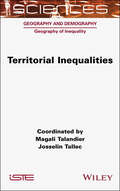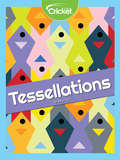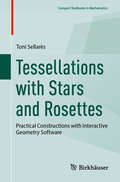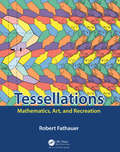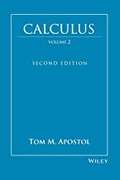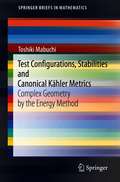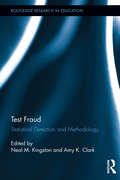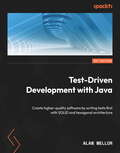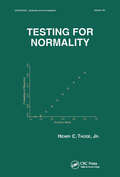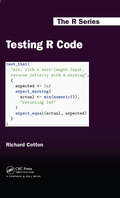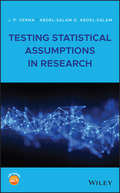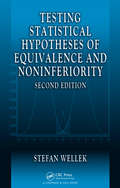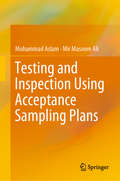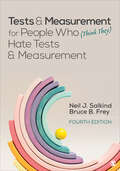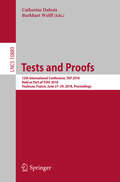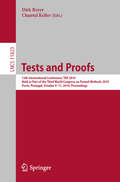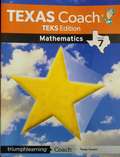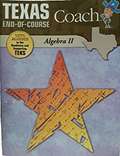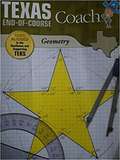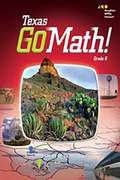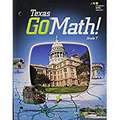- Table View
- List View
Territorial Inequalities
by Magali Talandier Josselin TallecSpatial planning has embraced the idea of dealing with territorial inequalities by focusing on equipment logic on a national scale, and then economic development on a local scale. Today, this issue is creating new angles of debate with strong political resonances (e.g. Brexit, French gilets jaunes movement). Interpretations of these movements are often quick and binary, such as: the contrast between metropolises and peripheries, between cities and the countryside, between the north and the south or between the east and the west of the European Union. Territorial Inequalities sheds light on the social, political and operational implications of these divergences. The chapters cover the subject at different scales of action and observation (from the neighborhood to the world), but also according to their interdependences. To deal with such a vast and ambitious theme, the preferred approach is that of territorial development in terms of public policy, namely spatial planning.
Tessellations
by Amy TaoPatterns are an important and often beautiful part of our world. One such pattern is a tessellation, or a series of shapes that is arranged in a manner that repeats itself with no gaps. Learn how to make your own tessellation with a fun craft!
Tessellations with Stars and Rosettes: Practical Constructions with Interactive Geometry Software (Compact Textbooks in Mathematics)
by Toni SellarèsThe main objective of the book is to teach how to practically construct periodic tessellations with stars and rosettes using an Interactive Geometry Software (IGS). Stars and rosettes are among the most characteristic geometric ornamental motifs of Islamic art. They are found on walls, ceilings, doors, and windows in both religious and secular buildings. Tessellations are repetitive patterns of shapes that fit together without gaps or overlaps, and they are periodic when they can be constructed by translations of a shape in two different directions. Periodic tessellations with stars and rosettes are complex and symmetrical compositions with rhythmic repetitions of profound beauty. An IGS allows to create and manipulate geometric constructions, producing accurate drawings. The book only assumes knowledge of basic geometric concepts and is self-contained while also providing all the necessary background information. Tessellations with Stars and Rosettes is aimed at students and graduates of mathematics, design, architecture, artists, and art historians, as well as anyone who wants to draw tessellations of stars and rosettes using IGS. It is suitable for a trimester or a semester course, and can also be used for self-study.
Tessellations: Mathematics, Art, and Recreation
by Robert FathauerTessellations: Mathematics, Art and Recreation aims to present a comprehensive introduction to tessellations (tiling) at a level accessible to non-specialists. Additionally, it covers techniques, tips, and templates to facilitate the creation of mathematical art based on tessellations. Inclusion of special topics like spiral tilings and tessellation metamorphoses allows the reader to explore beautiful and entertaining math and art. The book has a particular focus on ‘Escheresque’ designs, in which the individual tiles are recognizable real-world motifs. These are extremely popular with students and math hobbyists but are typically very challenging to execute. Techniques demonstrated in the book are aimed at making these designs more achievable. Going beyond planar designs, the book contains numerous nets of polyhedra and templates for applying Escheresque designs to them. Activities and worksheets are spread throughout the book, and examples of real-world tessellations are also provided. Key features Introduces the mathematics of tessellations, including symmetry Covers polygonal, aperiodic, and non-Euclidean tilings Contains tutorial content on designing and drawing Escheresque tessellations Highlights numerous examples of tessellations in the real world Activities for individuals or classes Filled with templates to aid in creating Escheresque tessellations Treats special topics like tiling rosettes, fractal tessellations, and decoration of tiles
Test Calculus: Volume 2
by Tom M. ApostolAn introduction to the calculus, with an excellent balance between theory and technique. Integration is treated before differentiation -- this is a departure from most modern texts, but it is historically correct, and it is the best way to establish the true connection between the integral and the derivative. Proofs of all the important theorems are given, generally preceded by geometric or intuitive discussion. This Second Edition introduces the mean-value theorems and their applications earlier in the text, incorporates a treatment of linear algebra, and contains many new and easier exercises. As in the first edition, an interesting historical introduction precedes each important new concept.
Test Configurations, Stabilities and Canonical Kähler Metrics: Complex Geometry by the Energy Method (SpringerBriefs in Mathematics)
by Toshiki MabuchiThe Yau-Tian-Donaldson conjecture for anti-canonical polarization was recently solved affirmatively by Chen-Donaldson-Sun and Tian. However, this conjecture is still open for general polarizations or more generally in extremal Kähler cases. In this book, the unsolved cases of the conjecture will be discussed.It will be shown that the problem is closely related to the geometry of moduli spaces of test configurations for polarized algebraic manifolds. Another important tool in our approach is the Chow norm introduced by Zhang. This is closely related to Ding’s functional, and plays a crucial role in our differential geometric study of stability. By discussing the Chow norm from various points of view, we shall make a systematic study of the existence problem of extremal Kähler metrics.
Test Fraud: Statistical Detection and Methodology (Routledge Research in Education)
by Neal M. Kingston Amy K. ClarkThere has been an increase in awareness (and perhaps occurrence) of individual and organized cheating on tests. Recent reports of widespread problems with state student accountability tests and teacher certification testing have raised questions about the very validity of assessment programs. While there are several books that specifically detail the issues of test security cheating on assessments, few outline the statistical procedures used for detecting various types of potential test fraud and the associated research findings. Without a significant research literature base, the new generation of researchers will have little opportunity or incentive to improve on existing methods. Enlisting a variety of experts and scholars in different fields of testing, this edited volume expands on the current literature base by including examples of detailed research findings arrived at by statistical methodology. It also provides a synthesis of the current state of the art with regard to the statistical detection of testing infidelity, particularly for large-scale assessments. By presenting methods currently used by testing organizations and research on new methods, the volume offers an important forum for expanding the literature in this area.
Test-Driven Development with Java: Create higher-quality software by writing tests first with SOLID and hexagonal architecture
by Alan MellorDrive development with automated tests and gain the confidence you need to write high-quality softwareKey FeaturesGet up and running with common design patterns and TDD best practicesLearn to apply the rhythms of TDD – arrange, act, assert and red, green, refactorUnderstand the challenges of implementing TDD in the Java ecosystem and build a planBook DescriptionTest-driven development enables developers to craft well-designed code and prevent defects. It's a simple yet powerful tool that helps you focus on your code design, while automatically checking that your code works correctly. Mastering TDD will enable you to effectively utilize design patterns and become a proficient software architect.The book begins by explaining the basics of good code and bad code, bursting common myths, and why Test-driven development is crucial. You'll then gradually move toward building a sample application using TDD, where you'll apply the two key rhythms -- red, green, refactor and arrange, act, assert. Next, you'll learn how to bring external systems such as databases under control by using dependency inversion and test doubles. As you advance, you'll delve into advanced design techniques such as SOLID patterns, refactoring, and hexagonal architecture. You'll also balance your use of fast, repeatable unit tests against integration tests using the test pyramid as a guide. The concluding chapters will show you how to implement TDD in real-world use cases and scenarios and develop a modern REST microservice backed by a Postgres database in Java 17.By the end of this book, you'll be thinking differently about how you design code for simplicity and how correctness can be baked in as you go.What you will learnDiscover how to write effective test cases in JavaExplore how TDD can be incorporated into crafting softwareFind out how to write reusable and robust code in JavaUncover common myths about TDD and understand its effectivenessUnderstand the accurate rhythm of implementing TDDGet to grips with the process of refactoring and see how it affects the TDD processWho this book is forThis book is for expert Java developers and software architects crafting high-quality software in Java. Test-Driven Development with Java can be picked up by anyone with a strong working experience in Java who is planning to use Test-driven development for their upcoming projects.
Testing For Normality
by Henry C. ThodeDescribes the selection, design, theory, and application of tests for normality. Covers robust estimation, test power, and univariate and multivariate normality. Contains tests ofr multivariate normality and coordinate-dependent and invariant approaches.
Testing R Code (Chapman & Hall/CRC The R Series)
by Richard CottonLearn how to write R code with fewer bugs. The problem with programming is that you are always one typo away from writing something silly. Likewise with data analysis, a small mistake in your model can lead to a big mistake in your results. Combining the two disciplines means that it is all too easy for a missed minus sign to generate a false prediction that you don’t spot until it’s too late. Testing is the only way to be sure that your code, and your results, are correct. Testing R Code teaches you how to perform development-time testing using the testthat package, allowing you to ensure that your code works as intended. The book also teaches run-time testing using the assertive package; enabling your users to correctly run your code. After beginning with an introduction to testing in R, the book explores more advanced cases such as integrating tests into R packages; testing code that accesses databases; testing C++ code with Rcpp; and testing graphics. Each topic is explained with real-world examples, and has accompanying exercises for readers to practise their skills — only a small amount of experience with R is needed to get started!
Testing Statistical Assumptions in Research
by J. P. Verma Abdel-Salam G. Abdel-SalamComprehensively teaches the basics of testing statistical assumptions in research and the importance in doing so This book facilitates researchers in checking the assumptions of statistical tests used in their research by focusing on the importance of checking assumptions in using statistical methods, showing them how to check assumptions, and explaining what to do if assumptions are not met. Testing Statistical Assumptions in Research discusses the concepts of hypothesis testing and statistical errors in detail, as well as the concepts of power, sample size, and effect size. It introduces SPSS functionality and shows how to segregate data, draw random samples, file split, and create variables automatically. It then goes on to cover different assumptions required in survey studies, and the importance of designing surveys in reporting the efficient findings. The book provides various parametric tests and the related assumptions and shows the procedures for testing these assumptions using SPSS software. To motivate readers to use assumptions, it includes many situations where violation of assumptions affects the findings. Assumptions required for different non-parametric tests such as Chi-square, Mann-Whitney, Kruskal Wallis, and Wilcoxon signed-rank test are also discussed. Finally, it looks at assumptions in non-parametric correlations, such as bi-serial correlation, tetrachoric correlation, and phi coefficient. An excellent reference for graduate students and research scholars of any discipline in testing assumptions of statistical tests before using them in their research study Shows readers the adverse effect of violating the assumptions on findings by means of various illustrations Describes different assumptions associated with different statistical tests commonly used by research scholars Contains examples using SPSS, which helps facilitate readers to understand the procedure involved in testing assumptions Looks at commonly used assumptions in statistical tests, such as z, t and F tests, ANOVA, correlation, and regression analysis Testing Statistical Assumptions in Research is a valuable resource for graduate students of any discipline who write thesis or dissertation for empirical studies in their course works, as well as for data analysts.
Testing Statistical Hypotheses of Equivalence and Noninferiority
by Stefan WellekWhile continuing to focus on methods of testing for two-sided equivalence, Testing Statistical Hypotheses of Equivalence and Noninferiority, Second Edition gives much more attention to noninferiority testing. It covers a spectrum of equivalence testing problems of both types, ranging from a one-sample problem with normally distributed observations
Testing and Inspection Using Acceptance Sampling Plans
by Muhammad Aslam Mir Masoom AliThis book introduces a number of new sampling plans, such as time truncated life tests, skip sampling plans, resubmitted plans, mixed sampling plans, sampling plans based on the process capability index and plans for big data, which can be used for testing and inspecting products, from the raw-materials stage to the final product, in every industry using statistical process control techniques. It also presents the statistical theory, methodology and applications of acceptance sampling from truncated life tests. Further, it discusses the latest reliability, quality and risk analysis methods based on acceptance sampling from truncated life, which engineering and statisticians require in order to make decisions, and which are also useful for researchers in the areas of quality control, lifetime analysis, censored data analysis, goodness-of-fit and statistical software applications. In its nine chapters, the book addresses a wide range of testing/inspection sampling schemes for discrete and continuous data collected in various production processes. It includes a chapter on sampling plans for big data and offers several illustrative examples of the procedures presented. Requiring a basic knowledge of probability distributions, inference and estimation, and lifetime and quality analysis, it is a valuable resource for graduate and senior undergraduate engineering students, and practicing engineers, more specifically it is useful for quality engineers, reliability engineers, consultants, black belts, master black belts, students and researchers interested in applying reliability and risk and quality methods.
Tests & Measurement for People Who (Think They) Hate Tests & Measurement
by Bruce B. Frey Neil J. SalkindWith a signature, conversational writing style and straightforward presentation, Neil J. Salkind’s best-selling Tests & Measurement for People Who (Think They) Hate Tests & Measurement guides readers through an overview of categories of tests, the design of tests, the use of tests, and some of the basic social, political, and legal issues that the process of testing involves. New co-author Bruce B. Frey has streamlined the table of contents for ease of use; added more content on validity and reliability throughout; more closely connected standardized tests to classroom instruction, adding more on classroom assessment; and added a chapter on surveys and scale development. An instructor website includes a test bank and PowerPoint slides.
Tests & Measurement for People Who (Think They) Hate Tests & Measurement
by Bruce B. Frey Neil J. SalkindWith a signature, conversational writing style and straightforward presentation, Neil J. Salkind’s best-selling Tests & Measurement for People Who (Think They) Hate Tests & Measurement guides readers through an overview of categories of tests, the design of tests, the use of tests, and some of the basic social, political, and legal issues that the process of testing involves. New co-author Bruce B. Frey has streamlined the table of contents for ease of use; added more content on validity and reliability throughout; more closely connected standardized tests to classroom instruction, adding more on classroom assessment; and added a chapter on surveys and scale development. An instructor website includes a test bank and PowerPoint slides.
Tests and Proofs: 12th International Conference, TAP 2018, Held as Part of STAF 2018, Toulouse, France, June 27-29, 2018, Proceedings (Lecture Notes in Computer Science #10889)
by Catherine Dubois Burkhart WolffThis book constitutes the refereed proceedings of the 12th International Conference on Tests and Proofs, TAP 2018, held as part of STAF 2018, in Toulouse, France, in June 2018. The 8 regular papers, 2 short papers, 1 invited paper and 1 invited tutorial presented in this volume were carefully reviewed and selected from 18 submissions. The TAP conference promotes research in verification and formal methods that targets the interplay of proofs and testing: the advancement of techniques of each kind and their combination, with the ultimate goal of improving software and system dependability.
Tests and Proofs: 13th International Conference, TAP 2019, Held as Part of the Third World Congress on Formal Methods 2019, Porto, Portugal, October 9–11, 2019, Proceedings (Lecture Notes in Computer Science #11823)
by Dirk Beyer Chantal KellerThis book constitutes the refereed proceedings of the 13th International Conference on Tests and Proofs, TAP 2019, held as part of the Third World Congress on Formal Methods 2019, Porto, Portugal, in October 2019. The 10 regular papers and 2 invited paper presented in this volume were carefully reviewed and selected from 19 submissions. The TAP conference promotes research in verification and formal methods that targets the interplay of proofs and testing: the advancement of techniques of each kind and their combination, with the ultimate goal of improving software and system dependability.
Texas Coach, TEKS Edition, Mathematics, Grade 3
by Triumph Learning"This book will help you to strengthen your mathematics skills. These skills are important to have for every subject you study this year, not just Mathematics. Each lesson in this book has three parts: 1 GETTING THE IDEA Review some of the basic concepts and skills you've already learned. 2 COACHED EXAMPLE Solve a problem. There are several questions that will help you along the way! 3 LESSON PRACTICE Now you're on your own! This part contains more problems to solve. There are different types of test items in Texas Coach, For some, you will have to choose one answer from several possible choices. For others, you will grid in the numbers for your answer. Be sure to read the directions carefully so you know how to answer each item. "
Texas Coach, TEKS Edition, Mathematics, Grade 4
by Triumph LearningThis book will help you to strengthen your mathematics skills. These skills are important to have for every subject you study this year, not just Mathematics. Each lesson in this book has three parts: 1 GETTING THE IDEA Review some of the basic concepts and skills you've already learned. 2 COACHED EXAMPLE Solve a problem. There are several questions that will help you along the way! 3 LESSON PRACTICE Now you're on your own! This part contains more problems to solve. There are different types of test items in Texas Coach, For some, you will have to choose one answer from several possible choices. For others, you will grid in the numbers for your answer. Be sure to read the directions carefully so you know how to answer each item.
Texas End-of-Course Coach Geometry
by Theresa DuhonThis book provides instruction and practice that will help students master the skills they need to know. It also gives practice answering the kinds of questions they will see on their state test.
Texas Go Math! Grade 6
by Timothy D. Kanold Edward B. Burger Juli K. Dixon Steven J. Leinwand Matthew R. Larson Martha E. Sandoval-MartinezMathematics textbook for 6th graders
Texas Go Math! Grade 7
by Timothy D. Kanold Edward B. Burger Juli K. Dixon Martha E. Sandoval-Martinez Matthew R. Larson Steven J. LeinwandMath textbook for grade 7 students.
